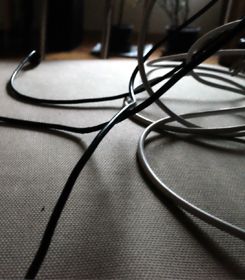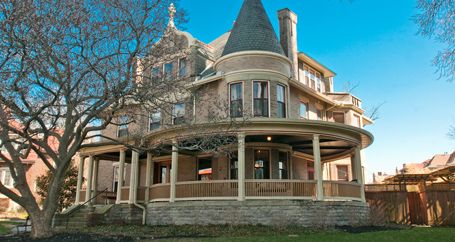Chris Powicki didn’t pay much mind to a loud pop he heard from his woodstove’s fire one cold November morning. But he snapped to attention five minutes later when the acrid aroma of roofing tar greeted him as he stepped outside.
“I looked up and saw flames about six inches high right along the roof’s ridgeline,” he says. “I ran in and yelled to my wife, ‘Elizabeth, the house is on fire — get the cats!’”
Fortunately, their wood-frame house in Brewster, Massachusetts — which dates to the 17th century — escaped largely unharmed. The fire itself was restricted to a small piece of the roof, where a spark from the woodstove had landed. The most serious damage was actually caused by water sprayed to douse the blaze, which destroyed plaster in several rooms.
As it turned out, the small disaster was a stroke of luck. Repairing the damaged plaster exposed a potentially bigger fire hazard: deteriorating knob-and-tube electrical wiring — a technology U.S. electrical contractors haven’t used since the 1940s.
WHAT IS KNOB-AND-TUBE WIRING?
Look at a lightweight extension cord. It appears to be two wires separated — and joined — by plastic insulation. Modern branch-circuit wiring — the wiring that runs from a breaker panel through the rest of the house — is a heavier duty version of the same thing. The two wires (known as conductors) are individually insulated, then wrapped together into a single cable.
In knob-and-tube systems, the two wires were individually insulated and installed, and supported by porcelain knobs or tubes. (Porcelain is a low heat conductor and doesn’t conduct electricity.) Porcelain knobs supported wires along their path inside walls. When wiring had to pass through floor joists or wall studs, drill holes were protected by porcelain tubes.

Keep reading if your home is more than 40 years old
Knob-and-tube wiring is just one of the electrical issues buyers and owners of older homes might have to address. Some of these issues might be obvious during a first visit or inspection — an old-school fuse box instead of a circuit-breaker panel or too few outlets. Others, like knob-and-tube wiring behind plaster, might not be revealed until walls come down during a renovation.
A lot of homeowners could be living with these issues today. More than half of all U.S. homes were built before 1980, and more than 40 percent before 1970, according to 2017 U.S. Census Bureau figures. These dates are significant, according to Joseph Wages, technical adviser for education, codes and standards for the International Association of Electrical Inspectors, because this is around the time the National Electrical Code (NEC) started paying more attention to grounding and outlet placement. The N E C is referenced by most local building codes across the United States.

Wages’ rule of thumb: Homes more than 40 years old — built in the late 1970s or earlier — may have wiring that needs updating. People looking to buy older homes should pay special attention to electrical systems in pre-purchase inspections, he recommends.
“I think it goes back to the initial installation and whether [the electrical system] was installed by an electrical contractor,” Wages says, emphasizing that many decades-old electrical systems remain safe and functional. “It’s like building a house — if you don’t get the foundation right, you could end up having problems throughout the entire life of the home.”
Vintage appeal — and a mostly hidden web of wiring
For Powicki and his wife, Elizabeth Hopper, character — not wiring — was the most important quality when they first spotted their home a decade ago. Although they knew that outlet placement was spotty, they assumed the electrical service was in order because the home had a circuit-breaker panel with 200-amp service, the modern standard.
But a few years ago, the couple had an energy audit completed to qualify for insulation incentives offered by their electric utility. Auditors discovered heat signals characteristic of knob-and-tube wiring. Powicki, who’s an energy consultant and advocate by profession, went into research mode, reading papers back to the 1980s.

They thought the old wiring was limited to a few first-floor outlets, he says. “My questions were geared to, ‘Should we take it out?’ and the papers said, ‘No, it’s perfectly safe — it might be frayed, but if you don’t touch it, it’s fine.’”
After the roof fire, removing the damaged plaster revealed the true extent of the old wiring. An electrician traced the wires back to a first-floor junction box. Modern wiring had been brought from the breaker panel to that point and simply connected to the old network.
HOW MUCH POWER DO I NEED?
| Common Household Appliances | Power Demand | ||
|---|---|---|---|
| Common Household Appliances | Water heater |
Power Demand | 25 amps |
| Common Household Appliances | Hair dryer |
Power Demand | 15 amps |
| Common Household Appliances | Microwave |
Power Demand | 13 amps |
| Common Household Appliances | Clothes iron |
Power Demand | 13 amps |
| Common Household Appliances | Electric range |
Power Demand | 1.5 amps |
| Common Household Appliances | Dishwasher |
Power Demand | 10 amps |
| Common Household Appliances | Air conditioner |
Power Demand | 7.8 amps |
| Common Household Appliances | Refrigerator |
Power Demand | 6 amps |
| Common Household Appliances | Dehumidifier |
Power Demand | 4.8 amps |
| Common Household Appliances | LED TV |
Power Demand | 1.16 amps |
| Common Household Appliances | Desktop computer |
Power Demand | 0.75 amps |
According to Wages, there’s nothing inherently unsafe about knob-and-tube systems. If it’s been undisturbed by remodeling or other activities over the decades, it may be fine.
But here’s the potential problem: Insulation around knob-and-tube wires can grow brittle, and vibrations from hammering can make it crack and fail, says Wages. Also, mice and other rodents can chew on it.
“I think it just needs to be evaluated on a case-by-case basis by a qualified person,” he says.
According to Lewis Maffioli, president of Wilson Electric Company in Rockford, Illinois, the only real telltale sign that knob-and-tube wiring needs replacing is if a connected outlet stops working. “You’re either going to have power or not have power,” he says. “I don’t know that there’s any way to see if the wire’s good without taking down a wall.”

This older wiring also generally needs space for heat to dissipate. Packing energy-saving insulation into the walls around these systems may lead to overheating and fires.
Powicki and Hopper decided to forgo adding insulation in the walls where knob-and-tube was found.
“The knob-and-tube has been totally reliable,” Powicki says. “And the house otherwise leaks so much air that it’s not like those few areas make a big difference.”
With the fire-related repairs Hopper and Powicki are now planning, it’s currently unclear how much of the wiring that wasn’t exposed by damaged plaster will need to be replaced. Conversations with the local building inspector are still under way.
More common electrical problems in older homes
Maffioli has seen his fair share of older electrical systems in his 46 years in the business. Plenty of homes in his northern Illinois city have been standing a century or more. In addition to knob-and-tube wiring — which, like Wages, he considers generally safe if undisturbed — he sees other shortcomings common to older homes: not enough capacity and not enough outlets.

That old fuse box may work fine, but it can still become a problem

Breaker panels became standard in the late 1960s, but many older houses still have fuse boxes. They aren’t inherently unsafe, Wages says, but homeowner misuse can lead to catastrophe.
Often maxing out at a capacity of 60 amps, fuse boxes might not offer enough power for, say, a new electric range or central air-conditioning system. And replacing a blown fuse is more of a chore than simply flipping a breaker switch back on. If a fuse is burning out frequently, homeowners may be tempted to substitute a larger-capacity fuse — a 20-amp fuse in a 15-amp connector — allowing more devices to be plugged in but risking an overload, which poses the danger of overheating and fire.

Breaker panels became standard in the late 1960s, but many older houses still have fuse boxes. They aren’t inherently unsafe, Wages says, but homeowner misuse can lead to catastrophe.
Often maxing out at a capacity of 60 amps, fuse boxes might not offer enough power for, say, a new electric range or central air-conditioning system. And replacing a blown fuse is more of a chore than simply flipping a breaker switch back on. If a fuse is burning out frequently, homeowners may be tempted to substitute a larger-capacity fuse — a 20-amp fuse in a 15-amp connector — allowing more devices to be plugged in but risking an overload, which poses the danger of overheating and fire.

Short on outlets? Here’s what not to do
Maffioli often sees homeowners relying on lightweight extension cords when outlets are far apart or there are too few in a room. “They’re not heavy-duty cords, and people extend them like crazy,” he says. If the cords get caught between furniture and the wall, or under a carpet, heat can build up. The solution, he says, is to add new outlets.

The cost of adding outlets varies both by region and by where they’re needed in the house. New outlets on a first floor could be relatively easy if wiring can be run through an unfinished basement beneath the floor — and Maffioli estimates the cost at $200 to $300 per outlet. Running wire behind walls to add an outlet on an interior wall on the second floor would cost more.
The N E C’s latest edition requires that no space along a wall be more than six feet from an electrical outlet, and that there should be no more than 12 feet between outlets, Maffioli says. This allows an easy reach for most devices, such as lamps or electronics, typically manufactured with at least a six-foot cord.

The cost of adding outlets varies both by region and by where they’re needed in the house. New outlets on a first floor could be relatively easy if wiring can be run through an unfinished basement beneath the floor — and Maffioli estimates the cost at $200 to $300 per outlet. Running wire behind walls to add an outlet on an interior wall on the second floor would cost more.
The N E C’s latest edition requires that no space along a wall be more than six feet from an electrical outlet, and that there should be no more than 12 feet between outlets, Maffioli says. This allows an easy reach for most devices, such as lamps or electronics, typically manufactured with at least a six-foot cord.
Where a standard two-plug outlet may not be enough — in a home office with a modem, computer, printer and desk lamp, for example — Wages recommends considering a power strip with a surge protector instead of an extension cord.
“Look at the devices plugged into it, and make sure you don’t exceed the capacity of the power strip,” he says. The capacity is listed on the label on the back of the strip — 15 amps is a common rating.

Why three prongs are better than two

The number of outlets wasn’t a problem for Dan Rabold and his wife, Jen, when they and their two sons moved into their Topsfield, Massachusetts, home several years ago. Instead, it was the fact the outlets weren’t grounded. The house was built in 1965, before three-prong grounded outlets were common. Grounding helps protect appliances and other devices — and their users — from damage or electrical shock in the case of a power surge or other problem.

The number of outlets wasn’t a problem for Dan Rabold and his wife, Jen, when they and their two sons moved into their Topsfield, Massachusetts, home several years ago. Instead, it was the fact the outlets weren’t grounded. The house was built in 1965, before three-prong grounded outlets were common. Grounding helps protect appliances and other devices — and their users — from damage or electrical shock in the case of a power surge or other problem.
Rabold, a home-based software consultant, had rewired his previous home himself, under the supervision of an electrical contractor, so he felt confident about replacing the outdated outlets on his own.
However, the job turned out to be more of a chore than he anticipated, thanks to the home’s unpredictable wiring. Two of the three outlets in his office, for example, were on the same circuit, while the third was paired with outlets in a different room.
“I had my son down in the basement with a walkie-talkie, turning circuits on and off,” he says, to determine when an outlet was safe to disconnect and replace.
Like many older homes, the Rabolds’ had other electrical irregularities they have decided to just live with. For example, most rooms don’t have an overhead light. Instead, one outlet in each room is connected to a wall switch — to be used for a table lamp. So furniture has to be set up accordingly.
And the wiring in a great room added by the previous owners baffled the Rabolds at first. “The top socket of each outlet is controlled by a switch, but the bottom isn’t,” he says. “So half of what we had plugged in worked and the other half didn’t. To this day, I don’t understand the logic behind how this house was wired.”

When an easy fix is not enough: Time to power up
Not all electrical issues can be handled by simple fixes. Often homeowners might have to upgrade service with a new breaker panel that delivers more power. In most municipalities, 100-amp service is the minimum allowed in such replacement projects.
However, Maffioli recommends his customers boost their capacity to at least 200 amps. Even with today’s more efficient lighting systems, appliances and electronics, he says the higher capacity will make future home improvements — a new swimming pool or electric vehicle charging equipment, for instance – much easier. And the extra capacity would only raise the cost by some $600, he estimates.
Get a quote
Includes personal service from a Farmers agent.
Written by
The information contained in this page is provided for general informational purposes only. The information is provided by Farmers® and while we endeavor to keep the information up to date and correct, we make no representations or warranties of any kind, express or implied, about the completeness, accuracy, reliability, suitability or availability with respect to this article or the information, products, services or related graphics, if any, contained in this article for any purpose. The information is not meant as professional or expert advice, and any reliance you place on such information is therefore strictly at your own risk.
Related articles

Is Your Home Ready For Solar Power?

“A Smoke Alarm Saved My Life”

